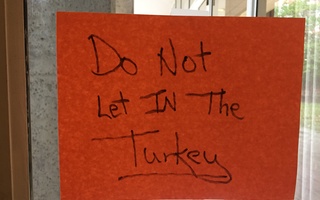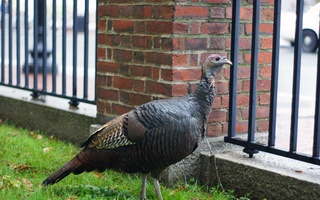If you are one of the lucky ones, you have glimpsed a turkey walking around Harvard’s campus, totally out of place but strutting its stuff nonetheless. Turkeys have long graced the North American wilderness, but there’s a reason tourists and students routinely stop to photograph them: It’s rare to spot a wild turkey because the majority of turkeys are now raised in factory farms, without ever having seen the light of day. The Harvard turkey is, therefore, among the luckiest of its kinsmen.
Each year, a whopping 46 million turkeys are killed for Thanksgiving celebrations. Unlike wild turkeys that are free to roam, forage, and live their lives naturally, these turkeys have been through the worst types of cruelty imaginable.
Industrial animal farms—or factory farms—house as many as 10,000 birds in one building. Turkeys remain in these facilities for about 99 days (for hens) or 136 days (for toms), according to Farm Sanctuary. During this time, their lives are a living hell.
They are fed antibiotics and hormones that have led the weight of the average turkey to increase by 57% from 1965 to 2000. These growth patterns cause crippling leg deformities, hip joint lesions, and bone defects that prevent them from walking. Due to the crowded conditions, turkeys often have their beaks and toes removed at a young age so they don’t damage other turkeys’ flesh and reduce their marketability. This procedure involves use of a hot blade or shears to cut off part of the nerve-sensitive beak or toe, without using pain reliever or anesthetic, according to Farm Sanctuary.
The treatment these turkeys receive from workers only adds to their misery. Workers have been documented kicking and stomping turkeys, draging them by their wings and necks, and routinely subjecting them to other forms of cruelty. Butterball, the company that produces 30 percent of these 46 million turkeys, has been cited the past two years for egregious animal cruelty—but these fines they’ve paid are nominal and won’t prevent them from continuing to inflict the same type of treatment this year. In fact, there isn’t a federal law that regulates the treatment of turkeys during slaughter. Because the Humane Slaughter Act excludes both chickens and turkeys, which make up over 90 percent of the animals killed in the United States each year, producers are allowed to kill these birds in any way they choose. The typical process involves hanging them upside down by their legs, dunking them into electrified water, slitting their throats, and finally dunking them into scalding hot water to de-feather them, often before they are dead.
This year, I encourage you to fill your plate with all of the other delicious Thanksgiving options (mashed potatoes, green bean casserole, roasted brussel sprouts, candied yams, etc.) and leave turkey off. All of these delicious foods, any many more, can be eaten while knowing that no animal suffering contributed to your food coma!
Alicia M. Rodriguez is president of the Student Animal Legal Defense Fund at Harvard Law School.
Read more in Opinion
Trying to Make Sense of a Senseless TragedyRecommended Articles
-
Turkey Day Brings Business to Savenor'sSomeone has misplaced a 35-pound turkey, and Ron Savenor is getting a little nervous. The owner of Savenor's Market in
-
He's Got GameIn September 1990, Nicholas P. Orenstein ’05 went on a run-of-the-mill hunting trip with his dad. Clad in camouflage gear,
-
 Harvard Square Turkey Now Has Facebook Following
Harvard Square Turkey Now Has Facebook Following -
 The Harvard Turkeys Refuse to Go Away Before Thanksgiving Day
The Harvard Turkeys Refuse to Go Away Before Thanksgiving Day -
 Close Encounters of the Bird Kind
Close Encounters of the Bird Kind













